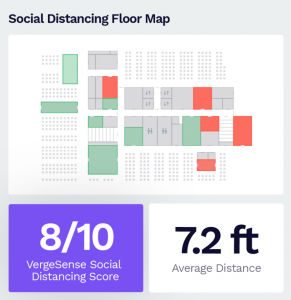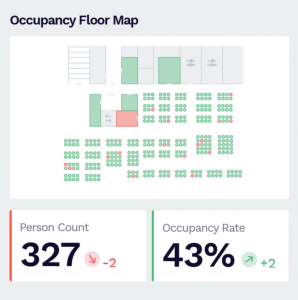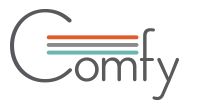Welcome to Comfy’s Partner Spotlight Series, featuring practical use cases and valuable industry perspectives from Comfy’s robust ecosystem of integration and strategic alliance partners. Our partners’ technology and services, in combination with Comfy’s workplace technology platform, help global enterprise clients drive and scale their workplace strategies.
Comfy’s partnership with VergeSense, a San Francisco based IoT Sensor provider, enables Real Estate teams to visualize real-time space utilization data and monitor the effectiveness of their health and safety policies. Companies can guide their return to the workplace strategies with a combination of VergeSense’s quick-to-deploy sensors and Comfy’s Safe Workplace package.
We spoke with Dan Ryan, CEO and Co-founder of VergeSense, about the importance of IoT Sensors in the COVID-era, the partnership with Comfy and more.
What changes are you currently seeing in the market around how customers are thinking about IoT Sensors in the COVID era?
Obviously with COVID, there's been a dramatic uptick in interest about using occupancy sensors to address social distancing and workplace compliance. It's a completely unanticipated use case. Dominant questions that companies are asking - When can I start allowing more people back into the office? How can I reassure employees who have been working from home for months that they can come back and stay healthy?
There are specific guidelines and compliance considerations around people occupancy. So, we've spent the past couple of months retooling a lot of our product capabilities to help support our customers as they execute the return to work strategy.
We've been seeing a lot of interest in more touchless interactions. A lot of customers are interested in more seamless, automated control systems. A lot of customers are also interested in mobile based booking and reservation of space. Whether it's automatically reserving or releasing desks or conference rooms, they’re interested in reducing the use of shared surfaces. That's an area where the combination of sensor data and solutions like Comfy, can provide a more seamless, safe experience for folks as they come back to the office.
Another category that we've seen is a lot of interest in using occupancy data for smarter cleaning. This was always something that people were sort of talking about. But now that companies have made cleaning a central safety consideration for their office spaces, we've been using occupancy data to help companies target and focus their cleaning efforts against the most frequently used areas.
Besides those quality examples, are there other areas where VergeSense sensors can help clients implement a safe return to the workplace for their employees?
People have been making physical changes to their office environments to help support social distancing. This includes pulling out conference room chairs, designating alternating desks, adding physical structures between desks, and adding physical signage to encourage social distancing. Our existing sensor product has the ability to report on social distancing compliance. We can actually measure the distance between people and then surface up that data to people in the Real Estate function to help them understand and measure if their workplace changes are effective.
We've seen some customers already make changes based on the data VergeSense has provided. They're identifying a specific conference room or specific area in which the changes to the physical environment weren't made and then going in to pull chairs, add signage, etc.
Another interest is around communicating occupancy data directly to employees. As people come back to the office, they want to know - where can I go? What are the safe spaces that are below target capacity rates?
That's something that we support via our API partners, such as Comfy. Sending real-time occupancy data to employees to allow them to find safe spaces to work.

Are there additional examples of particular value that customers gain from implementing VergeSense sensors throughout their office beyond addressing the needs from COVID?
The primary one is getting an accurate measurement of space utilization. Thinking about the post COVID world we've heard from a lot of customers that working from home is a habit that's going to permanently stick. Customers have an interest around more agile, dynamic seating, even as they think about coming back to the office. Anticipating that people are probably going to be coming into the office two to three days a week and not necessarily five days a week.
With that, there's questions like how many seats do I need? What should my seating ratio actually look like? Should we be 1.2 employees to 1 desk? Should we be 1.5 to 1?
Sensor data provides the decision-making engine that allows customers to actually identify a target seating ratio to implement in an agile seating center. That's something that we think is going to be a big part of the future.
With that, a big requirement is to integrate the sensor data with other mission critical systems, such as desk reservation, room reservation, etc. To make that experience seamless and effective for employees as they come back to the office.

What are the main differentiators for VergeSense sensors compared to other sensors in the market?
It boils down to the simplicity of price and performance. Because we have a 100 percent wireless option, we can install devices literally in seconds. They snap directly to the ceiling and they're able to cover a wide area.
Opposed to solutions where you have to put a sensor in every single desk or in every single chair in a conference room, a VergeSense sensor can cover eight desks in a typical scenario with one device. A device which is installed very quickly.
Because we use computer vision, we have the most accurate data stream available in the market today. The sensors can do person count - both within offices and above desk areas.
We can also use the computer vision technology to identify passive occupancy. If people are leaving stuff at the desk, it signifies occupancy. We have a specific feature called “Signs of Life” that can identify if a desk is occupied even if nobody's actually physically present there.
Also, VergeSense does not require connection with an existing IT network. We deploy the sensors so that they don't touch any corporate IT systems and can operate as a completely independent system. This allows us to scale and deploy quite rapidly relative to other solutions.
How does VergeSense account for those people? How are you determining if someone is actually occupying that space?
We use a combination of a low-resolution optical vision sensor and machine learning algorithms that process the data to count people. All of our data is 100 percent anonymous. We don't have the ability to identify anybody. With computer vision, we're able to deliver a solution that has incredibly high accuracy at a very low-cost point, that still preserves privacy.
What excites you about VergeSense’s partnership with Comfy?
The built environment is a massive space and no single vendor can do it all. There's so much value to deliver to customers. Comfy has a market leading user interface and mobile experience that we've deployed jointly together with customers across the globe. The combination of a highly accurate, reliable sensor data stream with a really amazing mobile experience, via the Comfy suite of products, provides end-users with a really compelling total solution. I’m excited by the work we've already done together jointly for some of the biggest companies across the world. It’s been quite successful.
For more COVID-19 workplace insights, explore Comfy's Return to Workplace Playbook and our new Safe Workplace solution.

 Request a Demo
Request a Demo






